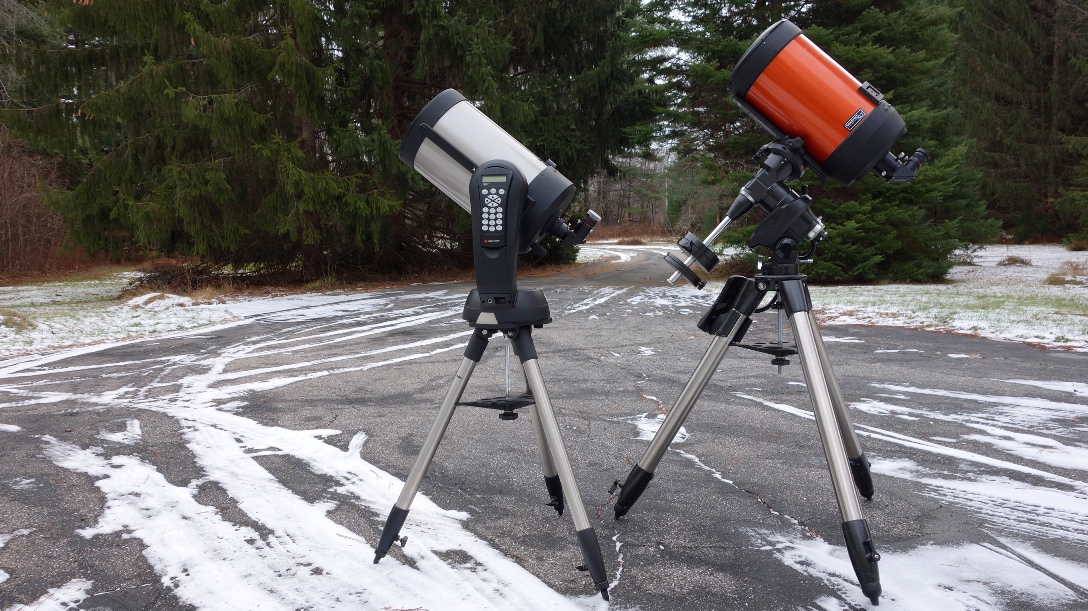
Updated 2/1/14
1) Celestron NexStar 8i (2003 version) 12/2/13
2) Vixen R130sf Reflector w/ Porta mount 2/1/14
(8" f/10 Schmidt-Cassegrain on single sided arm NexStar mount, red dot finder, 10 mm, 25 mm eyepieces, was $1599, now NLA and replaced by NexStar 8se @ $1099)
It's hard to believe these NexStar scopes have been around for ten years already. I remember when they first came out in the early 2000s - they seemed like such a bargain for what you were getting. Well, it's ten+ years later, and the new "se" versions of these NexStars cost 50% less, are more versatile, and do more. Still, these older gray-tubed NexStar "i" series scopes do show up on the used market at a fraction of their original list prices, and I'm often asked for my opinion of them. It just so happened that one of these 8i models got donated to the club recently, new in its original box and unopened. Thus, it was possible to duplicate what an owner might have experienced ten years ago. It was like opening a time machine.
The scope assembles easily once you take it out of the carton. One thing I noticed right away is that the older packaging seems a lot more robust than the newer cartons, which look a little thin and light to me. Although superficially the old and new NexStars appear to be very similar, there are some differences, and in all of the cases, the new versions are better. First, the old version separates into two parts - the tripod, and everything above it. The new "se" versions separate into the optical tube, and the entire mount. I prefer the latter - I like to stow just the OTA separately, and leave the entire mount in the back of the car. Also, the newer versions are mounted on a dovetail plate, in case you want to use the tube on another mount. The older "i" optical tube has a fixed bar that appears to be semi-permanently attached to the mount. In other words, if your NexStar "i" mounts die (and in my experience, they do die) you are left with a giant gray paperweight until you can figure out a way to attach a plate to it. I did notice that the long bar on this "i" unit does appear to come off with two allen screws. You could probably find a compatible plate from a place like Scopestuff, but I didn't try it.
I've said this before, but I think an 8" SCT is too big for a NexStar mount. The rig is seriously top-heavy and the view jiggles too much at anything over low power. Use a CG-5 or better if you're going to make serious use out of an 8 " SCT. At the time, however, you only had the choice of the NexStar 5i and the NexStar 8i, and for many people, a 5" SCT just isn't enough aperture. Luckily, today you can get a C6, and it's a happy compromise. A C6 works perfectly well on a NexStar mount and it's my favorite of the Celestron SCTs. At one time recently, I owned a C90, a C5, a C6, a C8, and a C9.25, and I used the C6 more than the others combined.
There are at least two versions of the software on these old NexStar units. I recall one older version that only had the 2-Star Align and the Auto Align. In other words, it made you go through an alignment process whether you wanted to or not. As someone who rarely uses a Goto system, this was a major pain. Luckily, the software on this 8i has a Quick Align, which allows you to get out of the alignment process within seconds and starts tracking right away. If you do the Quick Align, as I did almost all the time, you do have the option to Re-Align later on in case you want to go into Goto mode. On this 8i's firmware, the first option that shows up is a GPS align, but that only works if you have the optional CN16 accessory. Unfortunately, the GPS align option shows up first whether you have the CN16 or not, and this was a minor irritation every time I powered the scope up. They should have deleted the GPS align if you don't have the CN16, or at least moved the GPS option further down the menu do you don't have to look at it every time.
I had the scope for several weeks in Oct and Nov of 2013 during a lucky stretch of clear weather. I used a Power Tank to power up the scope. Due to the stability issues, I've described above, I rarely raised the tripod legs. If you're careful, you can stuff the whole scope inside your car in one piece. Just tilt the tube straight up and remove the red dot finder and slowly slide it into the back. And although it's against my nature, I used the Goto system almost every time I had it out. The pointing accuracy in Two Star mode is good. I made the scope do large and small slews, and for the most part, it performed very well. For example, going from M81 and M82 and back again caused no problems. As a severe test, I made the scope go from M51 to M15, and back again. Any time you cross the meridian on one of these Goto scopes, you risk losing accuracy. But I had to do this three times or more before the scope lost its place. A good plan when using a mount like this is to stay in a region of the sky for a while before moving to the other side of the sky. When you finally do so, you can either realign the scope in software, or just start over again.
The optics are typical of recent 8" Celestron Schmidt-Cassegrains, which is to say this tube was in the good to very good category. I won't go into details, but if you want to know more about these C8 tubes, see my C8 Tribute Page. The optics were only slightly out of collimation, and the diffraction patterns inside and outside of focus looked similar even in the 10 mm eyepiece. I had no complaints. One early morning I caught Jupiter, and the image was rock-steady, with a sharp black outline of a shadow transit on the white-ish ball of the planet. I looked at the typical late fall deep sky objects, including M11, M57, M56, Albireo, M27, M13, M92, M81/M82, NCG 789 and NGC 457 in Cass, and the Double Cluster. I tired to stay with the supplied 25 mm E-Lux eyepiece for a long as possible before switching to my 24 mm Panoptic. The E-Lux is fine for casual observing.
I am often asked if people should get the NexStar, or the equatorial version of these SCTs. The equatorial versions used to be sold with the CG-5 mount and were referred to as the ASGT series. They have since been upgraded to the VX series, and may well be called something else by the time you read this. Despite my preference for small, light equipment, I always tell people to get the equatorial version. Yes, the CG-5/VX is heavier and more expensive, but the mounts are more accurate, more stable, smoother, and (in my experience) more reliable. I do planetary and lunar imaging, for example, and I often get exasperated by the jerky movements and backlash of my NexStar mounts.

Compared to the C8 ASGT with the CG-5 mount
Looking at the image above, you can clearly see the longer, thicker legs of the CG-5. With the legs in the lowest position, the CG-5 still sits at a higher, more comfortable height. Even if you're a layman, you can sense the top-heavy profile of the NexStar 8i. Note the non-compatible black rail on the gray tube.
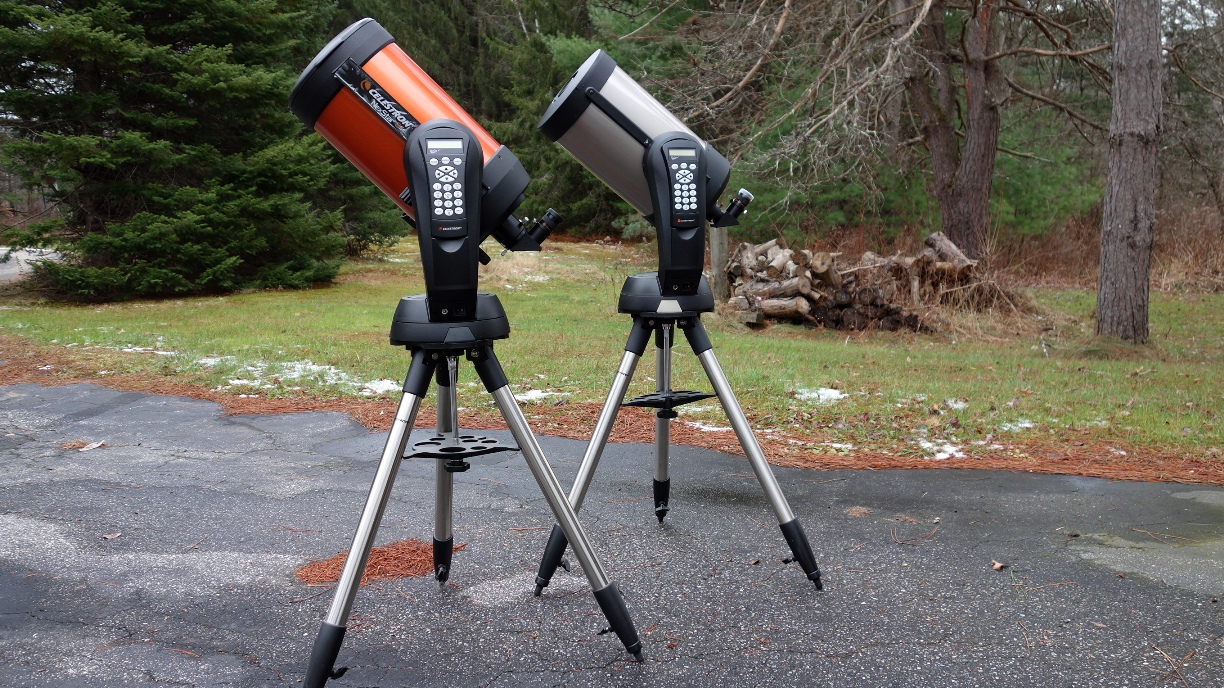
Compared to the new NexStar 8se version
To the untrained eye, these look similar, but look more carefully and you'll see the crucially-important Vixen-compatible dovetail plate on the newer orange tube. I still think both these tubes are too big and heavy for any NexStar mount; stick with the C6 or smaller if you must go this route. So, if one of these older gray tubed NexStars shows up, should you get one? It depends. I've seen them lately at very attractive prices - as in, you'd be pretty much getting the mount for free. Just be aware of my old adage: if you buy a computerized mount, assume it will fail. Because, at some point, they invariably do. Do you have a back up plan? Preferably, an inexpensive one?
Although I spent several trouble-free weeks looking through the scope, I'm hard-pressed to remember a single thing about the experience. In some ways, this is a good thing. It means the scope didn't do anything wrong to get my attention. But it does reinforce the old stereotype that these mid-aperture SCTs are the "master of none" - competent, if unexciting, performers. If that doesn't matter to you, the scope could be for you.
2) Vixen R130sf Reflector w/ Porta Mount 2/1/14
(130 mm f/5 Newtonian, Porta alt-az mount, 6x30 finder, 20 mm eyepiece, $399 street)
And the steady march of good, affordable equipment continues. I wound up buying one after seeing them out in the field, and at trade shows. This handsome telescope package sells for a reasonable $399, and you get the versatile Porta mount. The R130sf is light enough -only about 19 lbs total - to take out in one trip, and if you hold it just right, you can move it with one hand (the trick is to grab the Porta mount as high as possible without touching the tube.) It's also convenient for star parties, when kids are likely going to be running around and bumping into things in the dark. During the Polar Vortex days of early January 2014, when temperatures stayed below zero for several days, I wound up using the R130sf more than all of my other scopes combined. It was so cold, I could only stay outside for a few minutes at a time - not having to initialize a computer, or worry about batteries dying, was a big plus.
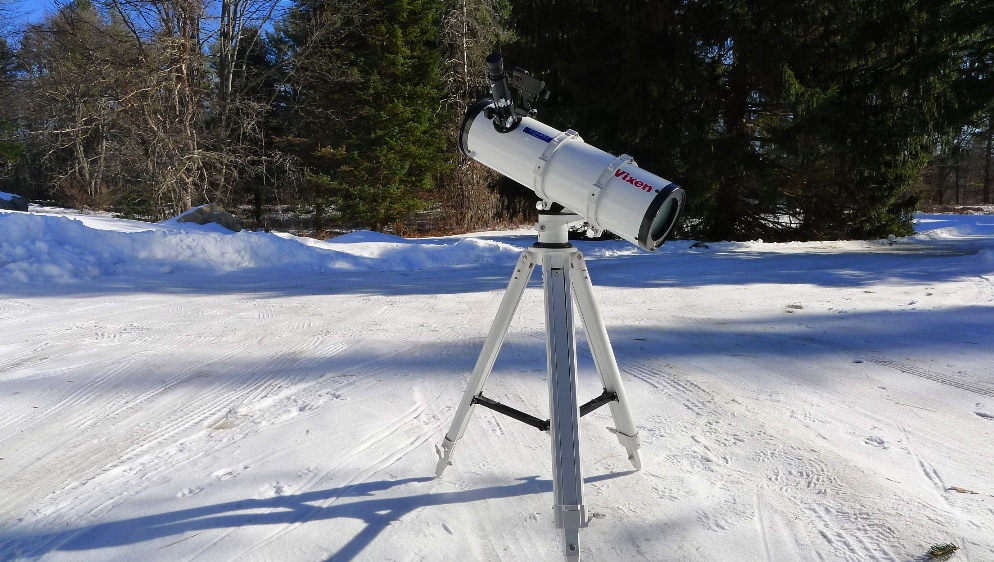
The R130sf rig in my cooooold driveway, January 2014
I have to confess - I had low expectations for the optics. I've been a little suspicious of mass-produced fast Newtonians recently, as the various 6" f/4, 8" f/4 OTAs I've seen have been OK, but not great optically. How would such an inexpensive f/5 reflector work out? I got a pleasant surprise. The optics are...really nice. The star patterns looked nearly identical inside and outside of focus with a 6 mm TMB eyepiece, yielding 108X, which is about as high as you want to go with the Porta mount anyway. The optics are better than on the 6" Starblast (more later on that tube.) What's more, there was very little drop off in sharpness at the edges of the field, even with cheap eyepieces. Eta Cass was a clean, easy split, with the wine-colored secondary easily spotted hugging the primary component.
With such a physically short optical tube, it invites you to swing it around and pan about the sky at will. One minute I was looking at clusters in Auriga, and then I suddenly felt like catching M31 before it sank in the west. Even near the horizon, the optics had enough contrast to pick out M33 from the background glow. On the very cold nights of January 23rd and 24th with the temperatures in single digits and the wind chills well below zero, I had the scope out to look at the supernova in M82. Although the nova registered 11th magnitude and was skirting the horizon, I could pick out the tiny star-like nova within M82 using averted vision about 80% of the time. On another clear night, I saw M42, M45, M1, M81/M82, M31, M33, NGC457, Eta Cass, NGC 7089, M35, M37, M36, M38, and Jupiter, all within a span of less then fifteen minutes. The mount is that fast, and that convenient to use. On January 29th, I watched a gorgeous shadow transit egress on Jupiter with a 7 mm Nagler (93X.) I have better planetary telescopes, including two outstanding Takahashi fluorites, but the thought of setting up an equatorial mount was just too much for such a cold night. Having the R130sf made the difference between seeing the transit, and not experiencing it at all.
Some of you reading this who are on the fence about this scope are probably chomping to buy one now. I'm not going to discourage you, and I'm going to issue a "strong buy" recommendation for it, but there are a couple of issues you need to be aware of. First of all, remove the thin black plate at the rear of the optical tube. Although it does act like a dust cover, it holds heat and prevents you from accessing the collimation screws. And those collimation screws are...a little odd. One set is screwdriver-driven, and the other set requires allen keys. While mine is in decent collimation, if you have to make adjustments, you could be in for a frustrating task.
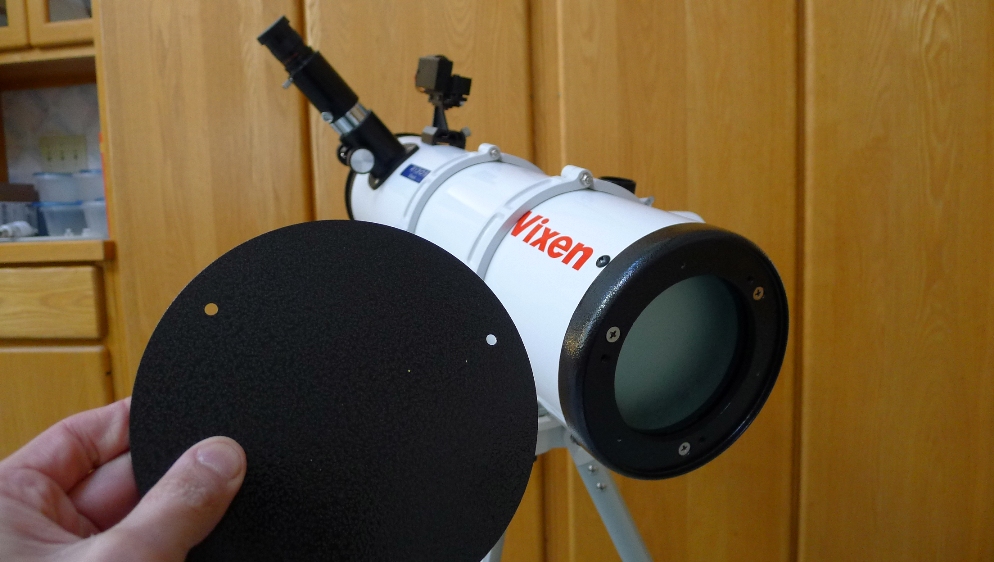
Take this off. And notice the mismatched collimation screws
More seriously, the scope uses an all-plastic focuser. I have been complaining about these focusers ever since they started appearing on the Orion Starblast 4.5," and while they may be acceptable for a $199 scope, I am less forgiving in a $400 scope. The focuser is the most used, and most touched part of your telescope; it is not the place to cheap out. Our club donates 4.5" Starblasts to local libraries, and we wind up replacing these focusers when ham-fisted patrons decide to crank down on them. Don't put your R130sf optical tube in the back of your car where it can roll around - the focuser is the part that gets hits the floor when the tube rolls around. Furthermore, the focuser on the R130sf has a proprietary thread-on extension tube that must be in place for visual use. If the focuser breaks, you're out of commission. During the cold days of January 2014, I found that the focuser on my R130sf became very stiff. Rather than risk damage, I packed it up for the evening more than once, rather than keep observing. Maybe I was being paranoid, but I felt I just couldn't risk it. This is unacceptable - I should never have to think about such a thing. Unfortunately, Orion also uses this plastic focuser on their much more expensive 6" Starblast, and I am depressed to see that my beloved Orion XT6 Dobsonian, the telescope model I recommend more than any other, is also sporting this unit now. I call on the industry to stop using these focusers. Charge me more for a better focuser; I will pay.
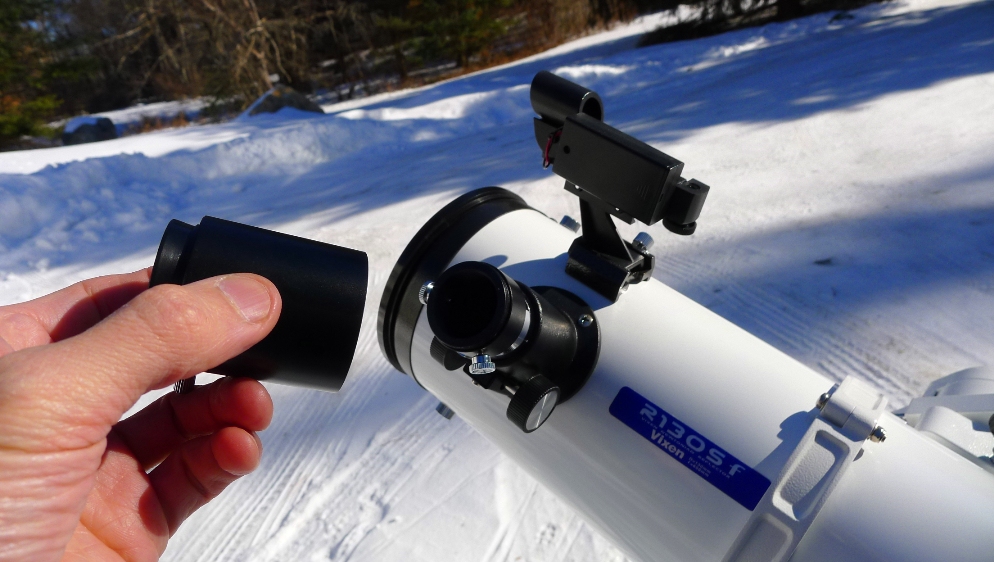
Not only is the focuser plastic, you need this proprietary thread-on extension tube for visual use
With these caveats in mind, if you're still inclined to buy one of these, I think you'll be very happy with it. There are other options in this price range. The Orion Starblast 6 ($329) offers more aperture for less money, but the tabletop design isn't as convenient as the Porta. Orion's XT6 Dobsonian ($269-~$300+ depending on options) is still my overall favorite scope for beginners and non-beginners alike. It has more aperture than the R130sf, a more stable base, and the f/8 optics are better. One factor tipping the scales in favor of the R130sf is the Porta mount. The mount accepts Vixen-compatible plates, so in theory you can buy this rig and place any one of a number of optical tubes on, depending on your mood. In fact, my 6" Starblast, which, after a series of exchanges within our club, has found its way back to me (somewhere along the line, it lost its base.) Although it's heavier than the R130sf tube (11.2 lbs vs 8.6 lbs) the 6" Starblast wound up being an excellent match with the Porta mount. Images are noticeably brighter, and the rig doesn't grow much in bulk. I found, for instance, that I could see the M82 supernova with direct vision most of the time, rather than needing averted vision with the stock R130sf tube. Starblast optical tubes are starting to show up on the used market. If you buy one of these Vixen rigs, consider picking one up. If I had to pick between all these scopes, I'd still recommend the XT6, but if you want to experiment with other tubes, the R130sf may be the one for you.
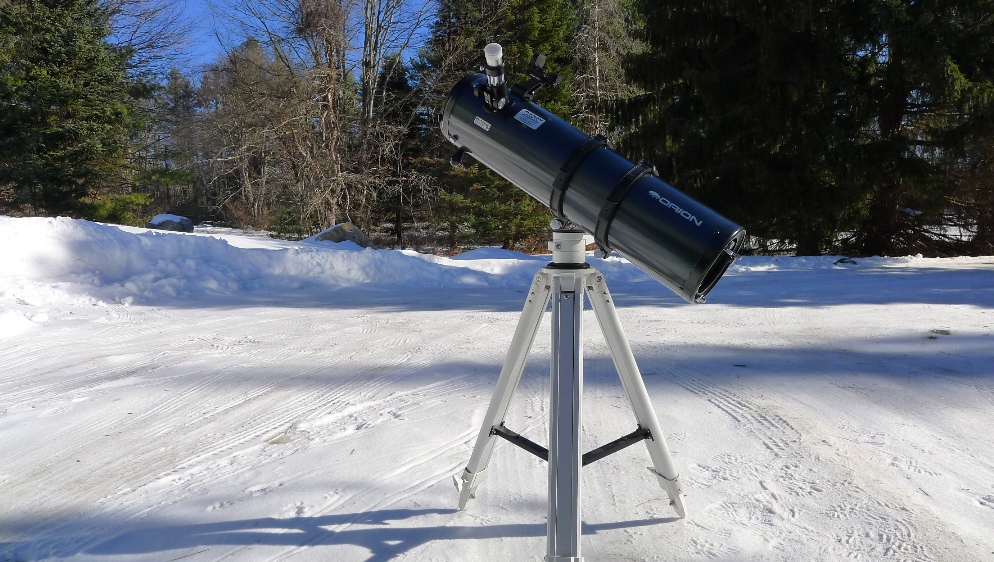
Orion's 6" Starblast on the Porta mount - An excellent observing combination
Vixen R130sf Hots:
Easy to use
Good optics
Versatile mount
Reasonable price
Vixen R130sf Nots:
Plastic focuser
Metal plate on back (easily removable)
Orion's XT6 is $100 cheaper